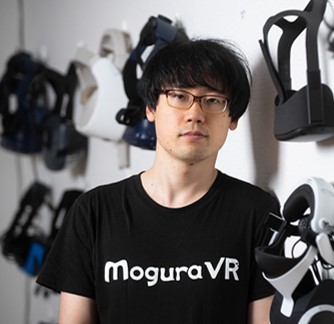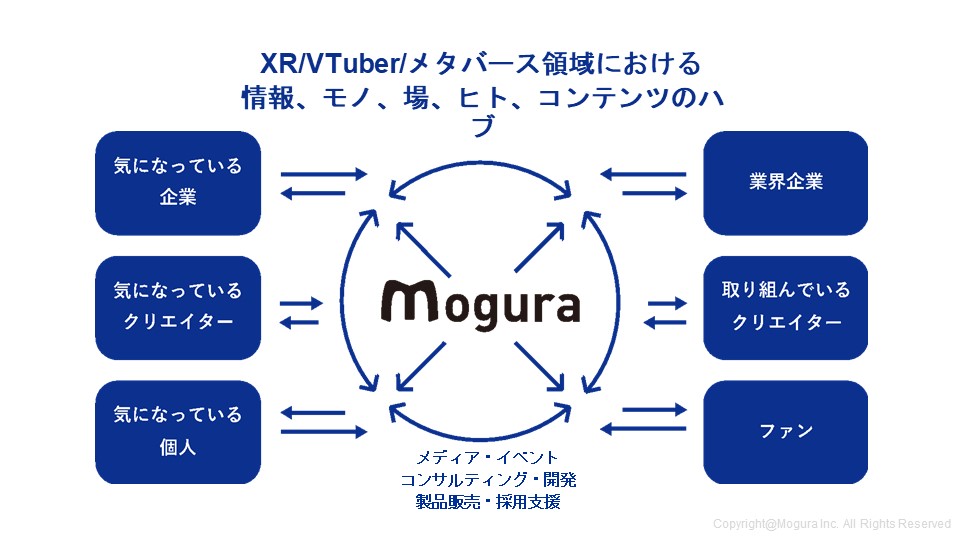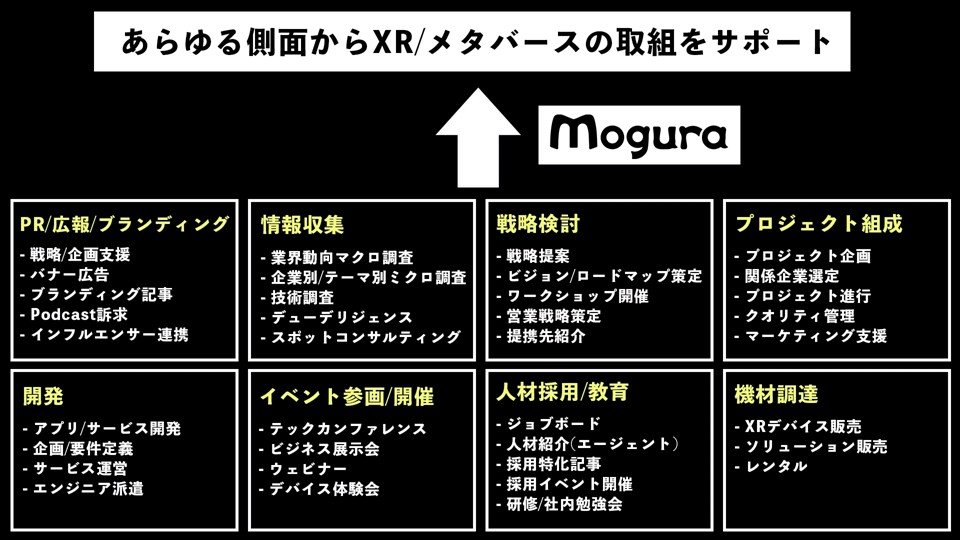Mr. Shun Kubota, CEO of Mogura, Inc.
Extended reality (XR), which encompasses virtual reality (VR), augmented reality (AR), and mixed reality (MR), VTubers, and the metaverse. These are technologies that Mogura, Inc. is striving to use to create a better world , and that integrate the real world with the virtual world to provide people with rich experiences. We interviewed Mr. Shun Kubota, the CEO of Mogura, Inc., about the company’s current initiatives and future prospects.

―After leaving the Ministry of the Environment of Japan which you had joined after graduation, you launched a VR-specialized media company and then founded Mogura Inc. Could you tell us how and why you founded Mogura?
In a word, I was fascinated by the infinite possibilities of changing society through VR technology. Given my background in law and previous career as a bureaucrat, you may wonder why I decided to enter the VR business. But, to tell the truth, I founded Mogura because of my unrivaled love of online games. Have you heard of ‘Lineage’?
―It’s an online game based on a Korean comic, right? I’ve heard that hundreds, or sometimes thousands, of players can participate in the game simultaneously over the Internet.
That’s right. I was obsessed with it from high school to college days. Not only the game itself, but also the feeling of people connecting with each other in the online space was very natural to me. It means that a kind of society was formed on the Internet. Knowing that feeling firsthand led me to start Mogura.
―So, the feeling of an online game is your starting point. What was the impetus that linked VR directly to your business?
With the feeling of that time, I left the Ministry of the Environment to start running Mogura VR, a media company specializing in XR and VTubers. Around that time, a VR headset called Oculus Rift was getting a buzz among many people, which became a decisive factor for me and convinced me that VR could change the world.
An early version of the Oculus Rift VR headset, released about 10 years ago, was far more primitive than today’s ones. But it was revolutionary for the time—it felt like something out of a world of science fiction. I realized that this technology, enabling us to immerse ourselves into a virtual world, was going to revolutionize society in the future. I then started to go further beyond games and collect and share information about VR,
I originally joined the Ministry of the Environment because I wanted to change the world for the better. I started Mogura with the same motivation. My approach has changed, but I think my core mission has remained unchanged.
―I see. On the other hand, didn’t you have any internal conflicts about leaving your job at the Ministry of the Environment, which is supposed to be respectable and stable?
As a government official, there are of course various restrictions on your work. I wanted to change my working environment, especially when considering my personal growth. What I realized after joining the ministry was that there were many other approaches than working for a government office to bring about positive impact on society.
―You are now disseminating information in various fields, right?
Over time, my focus has shifted from mere VR (virtual reality) to working on the realm of AR (augmented reality), which overlays the virtual world onto the real world to represent scenes in computer graphics. We have also started working on VTubers, a virtual version of YouTubers, and most recently, the metaverse. I have also published a book titled “Metaverse Mirai Senryaku (Metaverse Future Strategy)” from Nikkei Business Publications, Inc. to discuss how business will change when reality merges with the virtual world.
―As a leading expert in this industry, what do you find interesting about VR business?
Think of mobile phones, for example. They used to be large, boxy, and awkward and called shoulder phones 20 years ago, but they have become more and more convenient to use and their performance has improved dramatically. Now since we have smartphones, our interaction with the world has completely changed—they have become a world-changing tool.
For us, the virtual realm is exactly undergoing such an evolution.
We can accompany the process of that transformation and even have the possibility to set a direction ourselves. I think this is the interesting part of staying involved in this realm.
―I see. So, as a company, you are now focusing on expanding various technologies in the virtual realm, right?
Our mission is to “provide rich experiences to people all over the world”. We focus on four main business areas: VR; XR, which merges physical space with virtual reality; VTubers, where avatars are accepted in society; and the metaverse, a three-dimensional Internet. The expansion of the virtual realm is directly linked to the evolution of the world. Our business is to play the role of connecting people and companies and to disseminate the technology widely.


―Specifically, what are you working on?
First of all, we work as media that collect and disseminate information. This includes the operation of Mogura VR, the largest media in Japan specializing in VR, AR, MR, Vtubers, and the metaverse, as well as various podcasts, such as ‘MoguRadio,’ where we share the latest trends that you can listen to.
In order to create a place to accelerate development of the industry, we also hold various webinars more than once a month. XR Kaigi, our annual XR and metaverse industry conference, has already been held for the fifth time and grown into a major event with more than 100 exhibitors and a total attendance of about 3000 people.
In addition, we offer a one-stop consulting and development service called ‘Mogura Next’ covering research, development and service operation. We can also provide specific parts of this service as needed. As our scope of operation is very broad, we receive orders from a variety of entities, both in the public and private sectors, including large companies and startups, and our specialized teams are fully committed to support them.
―I’ve heard that XR is well compatible with the SDGs (Sustainable Development Goals) and that you have many successful examples.
Compared to other forms of communication, XR is the easiest tool to reproduce experiences and spaces. I believe that the use of XR can greatly increase users’ level of understanding and appeal to their emotions.
It’s said that the full spectrum of the SDGs is often not clear, which is a bottleneck for behavioral change. XR is suitable for visualizing those goals and helping overcome this barrier.
For example, we developed an AR system with DENSO CORPORATION to visualize their advanced ‘CO2 recycling technology’ facilities. The system allows a large number of visitors using AR devices to see and understand on site what kind of chemical reaction occurs in which equipment there and how these contribute carbon neutrality. The system was received very well because it made clear at a glance the specific mechanism and benefits of the recycling plant, which had been difficult to understand through text or video. Since its introduction in 2020, we have been continuously receiving orders for additional development and for the development of derivative systems.
―So, your system can visualize the details of a demonstration test in 3D on site and let people intuitively understand the benefits, which I think is impactful.
As DENSO also requested us to create an AR experience for their ‘flying car’ project, we worked to visualize those future technologies. We developed an AR system that allows users to visually experience the ‘flying car’ which is under development. The system has been appreciated because it directly conveys the benefits of a motorized product, which are difficult to convey through text or video. With the help of renowned creators, we are proud of the 3D texture and other aspects of the system.
―I’ve heard that your system also provides subtitles and audio narration in three languages: Japanese, Chinese, and English as well as high-quality AR images that have been tested multiple times and meticulously detailed.
Besides, another different challenge in visualization we faced with was to create VR to simulate a landscape for discussion with local residents of on Rishiri Island, Hokkaido who were concerned about the destruction of the landscape during offshore wind power development. We showed them 360-degree images of the anticipated post-development landscape in VR, which let them have a faster and deeper understanding of the project. We also built a system that allowed people at the site to view the same VR video all together, making explanation very smooth.
―It’s said that ‘seeing is believing.’ I certainly feel that if this kind of technology widely spreads, it will become a major driving force in changing the world. To close our conversion, could you tell us about your future prospects and expectations?
I’m confident that technology in the virtual realm will develop greatly in the future and surely become a catalyst for changing the world. It’s our unwavering wish to change the world for the better through this technology. We will keep disseminating information for people to encounter new technologies of the future.
| Company name: Mogura, Inc. |
| Founded:August 2016 |
| Number of employees:7 |
| Main Businesses:media management, event and exhibition planning and operation, research and consulting service related to XR, the metaverse, and VTubers URL:https://mogura.co |
This article is part of a series of articles introducing venture companies working together as ICF members to resolve societal issues.





